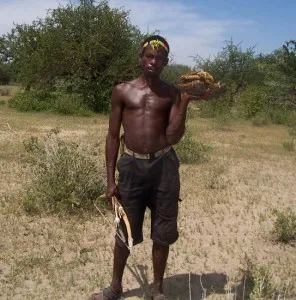Humans, the Honey Hunters
Energy-rich honey may have helped hominids evolve big brains
/https://tf-cmsv2-smithsonianmag-media.s3.amazonaws.com/filer/20111219010040humans-honey-hunter.jpg)
Anthropologists have suggested early Homo was a meat-and-potatoes kind of hominid. Starting roughly 2.5 million years ago, early species of Homo were the first hominids to have brains bigger than an ape’s. But brains are expensive, metabolically speaking. To fuel their added brain power, these hominids probably introduced new energy-rich foods to their diet. Researchers have long pointed to meat as the critical food that allowed for this initial brain expansion; after all, stone tools useful for hunting and butchering appear in the archaeological record at this time. More recently, the significance of underground tubers has been highlighted. But another crucial food may have been honey. Alyssa Crittenden, a behavioral ecologist and nutritional anthropologist at the University of Nevada, Las Vegas, makes the case for the sweet liquid’s importance in the journal Food and Foodways.
Honey has several qualities that make it a super food, Crittenden points out. It’s very energy dense, about 80 to 95 percent sugar, and it’s a good source of the glucose needed to nurture brain development. Wild honey also contains traces of bee larvae, adding fat, protein, vitamins and minerals. And on top of that, it’s easy to digest. The nutritional benefits of honey are clear, but there is no concrete evidence in the fossil record of hominids eating honey; honey consumption doesn’t leave behind the kind of scraps that can fossilize the way that hunting and butchering does. So Crittenden relies on some indirect clues to bolster her argument.
First, the significance of honey to human evolution may be inferred from the fact that the sugary liquid is an important dietary staple for people around the world. In Paraguay, for example, the Ache believe honey is the second most important food in their diet, after game meat; honey can provide an Ache with more than 1,100 calories per day. Honey can constitute 80 percent of the calories consumed by the Efe pygmy people of the Congo and 15 percent of the diet of the Hadza of Tanzania. Furthermore, people go to great lengths to get honey. The Hadza often follow honeyguide birds to hives of stinging bees. The honey hunters then burn brush near the entrance of the beehive to smoke out the bees, who become confused and disarmed by the smoke. In Nepal, honey collectors climb bamboo ladders positioned on cliff faces to access nests tucked away in crevices. Ancient art verifies that honey consumption is not a recent phenomenon. Rock art depicting honeycombs, swarms of bees and honey collecting date to as many as 40,000 years ago. Such art has been found in Africa, Europe, Asia and Australia.

Our primate cousins are another line of evidence. A variety of monkeys and apes eat honey today. Baboons and macaques, for example, use their hands and mouths to harvest honey from the nests of stingless bees. Orangutans, gorillas and chimpanzees also like honey and bee larvae, often using sticks to extract the food from hives. If these primates are able to procure honey, Crittenden says, “it is highly likely that early hominids were at least as capable of honey collection.” Like modern apes, australopithecines may have used sticks to retrieve honey. Honey may have become a larger component of the diet with the invention of stone tools, which would have allowed our ancestors to more easily open beehives, Crittenden says. “Their success rates would have skyrocketed.” Later, exactly when is debatable, mastering fire may have allowed hominids to smoke out stinging bees, as modern people do, making it even easier to collect honey.
Although Crittenden thinks honey was a critical food that allowed for brain expansion, she acknowledges it wasn’t the only food. Our ancestors were omnivores, she says. Meat, tubers, honey—and perhaps other foods—all helped hominids evolve their most notable feature.
/https://tf-cmsv2-smithsonianmag-media.s3.amazonaws.com/accounts/headshot/science-erin-wyman-240.jpg)
/https://tf-cmsv2-smithsonianmag-media.s3.amazonaws.com/accounts/headshot/science-erin-wyman-240.jpg)